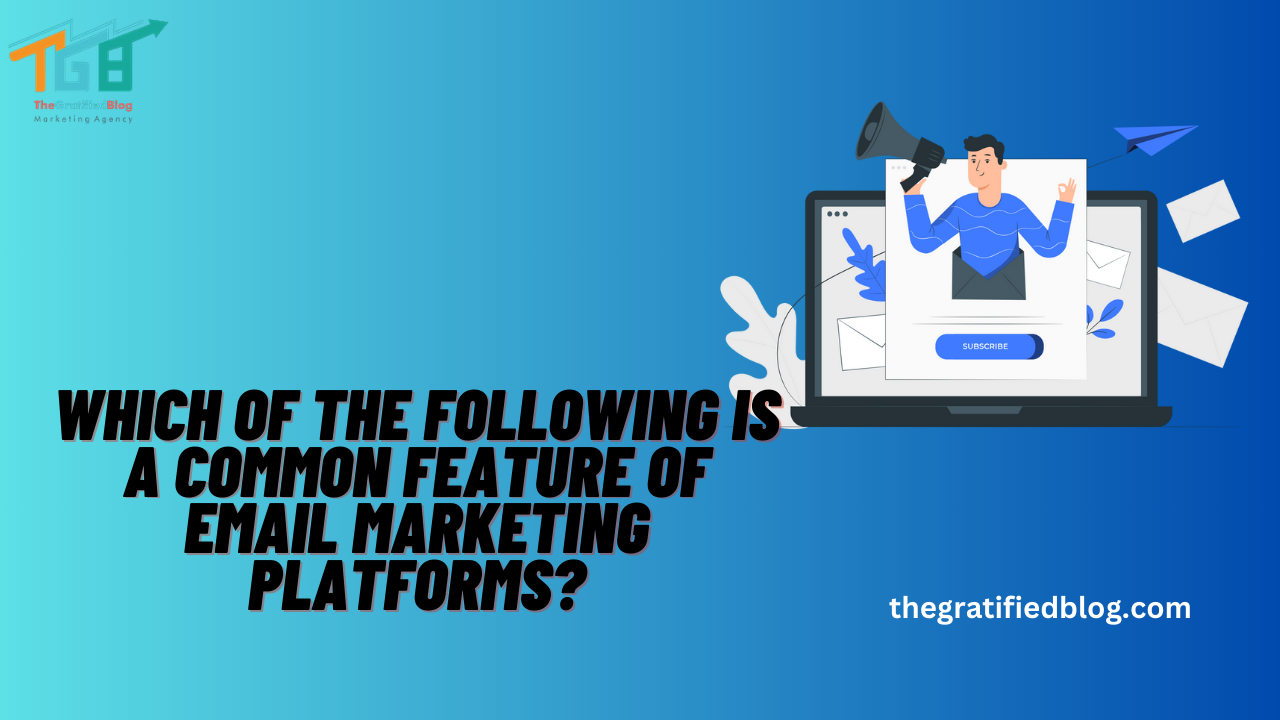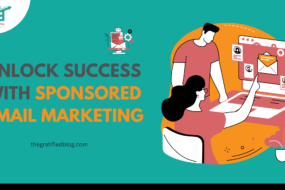
Welcome to our blog, where we unravel the intricacies of email marketing platforms and address a pivotal question: “Which Of The Following Is A Common Feature Of Email Marketing Platforms?”
Email marketing platforms have emerged as indispensable tools in today’s digital realm, where businesses navigate the ever-evolving landscape of customer engagement. Join us as we delve into the standard features that define these platforms, exploring their benefits, distinctions, and how they empower businesses to navigate the complexities of effective and personalized email campaigns.
Let’s unlock the secrets to optimizing your email marketing strategy and harnessing the full potential of these dynamic platforms.
So, let’s get started by understanding the email marketing platforms:
What Are Email Marketing Platforms?
Email marketing platforms, also known as email marketing software or email marketing automation tools, are specialized software solutions designed to facilitate the creation, management, and execution of email marketing campaigns.
These platforms offer a range of features and tools that empower businesses to send targeted, personalized emails to their subscribers, customers, or prospects.
Email marketing platforms are crucial for businesses looking to build and nurture relationships with their audience through email communication.
What Are The Benefits Of Email Marketing Platforms?
Email marketing platforms offer a multitude of benefits to businesses and marketers:
Targeted Marketing: These platforms enable precise audience segmentation, allowing you to send tailored messages to specific groups based on their demographics, behavior, or preferences. This level of customization empowers businesses to maximize the impact of their marketing efforts.
Companies can craft personalized campaigns that resonate with individual consumers by analyzing data such as age, location, and online activity. This not only boosts engagement but also enhances the likelihood of conversions.
Furthermore, targeted marketing minimizes wasted resources by narrowing your focus to those most likely interested in your product or service. This efficiency leads to a higher return on investment (ROI) and improved cost-effectiveness.
In today’s competitive landscape, reaching the right audience with the right message is essential for success. Targeted marketing helps businesses stand out and fosters stronger customer relationships as customers appreciate relevant content tailored to their needs.
Ultimately, these platforms provide a powerful means of creating a meaningful connection with your audience, driving brand loyalty, and achieving long-term business growth.
Automation: Email marketing platforms allow for automated email scheduling, follow-ups, and triggered responses, saving time and ensuring timely communication.
With scheduled emails, you can reach your audience when they’re most receptive, even if you’re in different time zones. Follow-up emails can nurture leads and keep your brand on their radar effortlessly.
Triggered responses can personalize interactions based on user behavior, enhancing engagement. Automation reduces the risk of human error in manual email management, improving accuracy. It also frees up your team to focus on strategy and creative aspects of your campaigns.
The ability to segment your audience for tailored messaging becomes seamless with automation, optimizing the relevance of your emails. You can track and analyze data in real-time, refining your strategies for better results.
Incorporating automation into your email marketing strategy streamlines operations and boosts customer engagement, leading to more conversions and a more substantial brand presence.
Personalization: Marketers can personalize emails with recipient names, product recommendations, and tailored content to enhance engagement and conversions.
This level of customization fosters a stronger connection with the audience, making them feel valued and understood. Addressing individuals by name creates an immediate familiarity, increasing the chances of your message being read.
Offering product recommendations based on their previous interactions or browsing history demonstrates that you’re attuned to their preferences.
This boosts the likelihood of a purchase and elevates customer satisfaction. Tailored content ensures that the information provided is relevant and valuable to the recipient, minimizing the chances of your email ending up in the spam folder.
In today’s competitive landscape, personalization is a powerful tool to set your brand apart. It fosters trust, loyalty, and a positive customer experience, improving ROI and long-term success. So, embrace personalization in your email marketing efforts and watch your engagement and conversion rates soar.
Analytics: Comprehensive reporting and analytics tools provide insights into email campaign performance, helping refine your strategies.
These data-driven insights empower you to make informed decisions and optimize email marketing efforts. By tracking open rates, click-through rates, and conversion metrics, you can gauge the effectiveness of your campaigns.
These tools allow you to segment your audience based on behavior and demographics, enabling highly targeted messaging. Real-time monitoring ensures you can adapt quickly to changing trends and customer preferences, maximizing engagement.
A/B testing capabilities help you experiment with elements like subject lines and content to find what resonates best with your subscribers.
These analytics aren’t just about numbers; they’re a window into your audience’s preferences and habits.
With this knowledge, you can tailor content that truly resonates, boosting customer loyalty and revenue. Ultimately, analytics are the compass guiding your email marketing strategy toward more tremendous success.
Scalability: Email marketing platforms can accommodate growing email lists and campaign complexity, making them suitable for businesses of all sizes.
Small startups can begin with a modest subscriber base and expand as they grow without needing a complete overhaul. These platforms offer flexible pricing models, ensuring costs remain manageable during expansion.
For mid-sized companies, email marketing platforms provide advanced segmentation and automation tools, allowing for more personalized and targeted campaigns.
This fosters better engagement and higher conversion rates. Large enterprises benefit from robust scalability, handling vast email lists effortlessly and maintaining consistency across multi-faceted marketing efforts.
Scalability also ensures marketing teams adapt swiftly to changing needs and audience dynamics. Whether you’re a budding entrepreneur or a corporate giant, email marketing platforms empower businesses to scale their outreach while retaining the efficiency and effectiveness that makes email marketing a valuable asset in the digital age.
Cost-Effective: Email marketing is generally more cost effective than traditional advertising methods, making it a budget-friendly marketing option.
This affordability stems from reduced printing and postage costs, as emails can reach a broad audience instantly. Moreover, email campaigns allow for precise targeting, ensuring your marketing dollars are spent on the most relevant audience.
Email marketing provides detailed analytics, helping you measure the success of your campaigns in real-time. It allows you to track open, click-through, and conversion rates, enabling you to make data-driven decisions for improved ROI.
Automation tools make it easier to streamline email campaigns, saving time and reducing labor costs. With email marketing, you can also personalize messages, enhancing engagement and customer relationships without breaking the bank.
Its cost-effectiveness, data-driven insights, and automation capabilities make email marketing an attractive and budget-friendly choice for businesses of all sizes.
What Is The Difference Between Email Marketing Platforms And Email Service Providers?
While the terms are sometimes used interchangeably, there is a distinction between email marketing platforms and email service providers (ESPs). ESPs primarily focus on delivering and managing email infrastructure, ensuring emails reach the recipients’ inboxes.
On the other hand, email marketing platforms provide a broader range of tools and features for creating, sending, and tracking email marketing campaigns.
Email marketing platforms offer features like audience segmentation, automation, personalization, and analytics, while ESPs focus on ensuring email deliverability and managing email servers. Often, businesses use both in conjunction to optimize their email marketing efforts.
Do Email Marketing Platforms Have Any Drawbacks?
While email marketing platforms offer numerous advantages, they also have some potential drawbacks:
Learning Curve: Mastery of these platforms can take time, and businesses may need to invest in training or hire experts to utilize them effectively. However, the benefits are substantial.
These tools can streamline operations, boost productivity, and enhance customer engagement. Overcoming the initial learning curve pays off through increased efficiency and profitability.
As employees become proficient, they can harness the full potential of these platforms, making them indispensable assets for the organization. Mastering these tools in the ever-evolving digital landscape is a wise investment for long-term success.
Cost: Although email marketing can be cost-effective, advanced features and large subscriber lists may lead to higher costs. It’s crucial to balance your budget and the potential returns.
Investing in quality email marketing tools and analytics can optimize your spending. Consider segmentation to target specific audiences effectively, reducing unnecessary expenses.
Regularly monitor your campaigns to identify cost-saving opportunities while maintaining campaign efficacy. Ultimately, cost management is integral to maximizing the benefits of email marketing for your business.
Spam Risk: Misuse of email marketing platforms or improper email practices can result in emails being marked as spam, potentially harming the sender’s reputation.
To avoid this, businesses should focus on building organic email lists and sending relevant content to engaged subscribers. Regularly clean and update email lists to remove inactive or unsubscribed contacts.
Utilize double opt-in processes to ensure recipients genuinely want to receive emails. Implement strong authentication and encryption measures to enhance email security.
By following these best practices, organizations can maintain a positive sender reputation and reach their target audience effectively.
Constant Updates: Email marketing platforms frequently release updates and new features, which may require ongoing adaptation. Staying current with these changes is essential for maximizing campaign effectiveness.
Marketers should regularly review platform documentation and attend webinars or training sessions to cope with evolving tools. Fostering a culture of curiosity and continuous learning within your marketing team can help ensure everyone is well-versed in the latest strategies and techniques.
Embracing these updates keeps you competitive and opens new opportunities to engage with your audience and drive results in the ever-evolving digital marketing landscape.
Which Of The Following Is A Common Feature Of Email Marketing Platforms?
Standard features of email marketing platforms include:
Email Campaign Management
Email marketing platforms allow users to create, manage, and schedule email campaigns, making sending targeted messages to their audience easy.
These platforms provide a range of features, including customizable templates, list segmentation, and A/B testing, to optimize email performance. Additionally, they offer analytics tools to track open rates, click-through rates, and conversion metrics, enabling businesses to refine their strategies.
Email marketing automation features streamline workflows by sending automated follow-up emails based on user interactions, enhancing customer engagement.
Personalization options enable tailored content for individual recipients, increasing the likelihood of conversions. Advanced targeting capabilities leverage subscriber data for precise campaigns, fostering more robust customer relationships.
Integration with CRM systems and other marketing tools enhances efficiency and data management. Overall, email campaign management platforms empower businesses to deliver compelling, data-driven email campaigns that drive results and foster brand growth.
Contact List Management
Users can import, organize, and segment their email lists to ensure they send emails to the right people. Effective contact list management is at the core of successful email marketing campaigns.
Importing contacts seamlessly streamlines the process, allowing users to add new subscribers effortlessly. Organizing contacts is crucial for targeted messaging.
Users can create folders, tags, or categories, making locating specific contacts easier and tailoring content accordingly. Segmentation is a powerful tool for personalization.
Users can divide their lists based on demographics, behavior, or engagement levels, ensuring messages resonate with each group. Users can deliver highly relevant content by separating lists and boosting open and click-through rates while reducing subscriptions.
Managing unsubscribes is also simplified. Users can automate this process, maintaining compliance with email marketing regulations.
Duplicate contacts are easily identified and removed, ensuring a clean and efficient list. Tracking engagement metrics becomes straightforward. Users can monitor opens, clicks, and conversions, allowing for data-driven improvements.
Automated list maintenance keeps lists up-to-date, reducing the risk of sending emails to inactive or incorrect addresses. Data import/export options provide flexibility, allowing users to seamlessly integrate their lists with other tools.
Users can customize contact fields, collecting specific information that enhances targeting and personalization. Advanced filtering capabilities enable users to narrow their lists further, refining their audience for precise targeting.
Contact list management simplifies subscriber management, helping users build and nurture relationships with their audience effectively.
By providing these tools, contact list management ensures users can optimize their email campaigns for better results and more meaningful connections with their subscribers.
Templates And Design Tools
These platforms often provide a variety of pre-designed email templates and drag-and-drop design tools, making it easy to create visually appealing emails.
With a selection of professionally crafted templates, users can choose one that aligns with their brand and message, saving time and effort in email creation.
These design tools offer customization options, allowing users to personalize templates with their brand colors, logos, and fonts. This ensures consistency in branding across all communication channels.
The intuitive drag-and-drop features make it simple for even non-designers to arrange elements, such as images, text, and buttons, within the email layout. Templates often include responsive designs, ensuring emails look great on various devices and screen sizes.
This responsiveness is crucial for reaching a diverse audience. The tools may provide A/B testing capabilities, helping users optimize email content for better engagement.
Some platforms offer analytics integration, enabling users to track email performance metrics like open, click-through, and conversion rates.
This data-driven approach helps marketers refine their email strategies for better results. These templates and design tools are valuable resources for creating impactful email campaigns.
Streamlined Email Creation
With templates and design tools, crafting eye-catching emails becomes a breeze. You can choose from many pre-made designs and customize them effortlessly to match your brand’s aesthetic.
Creative Freedom
These platforms empower you with creative freedom. You can experiment with different layouts, color schemes, and fonts, ensuring your emails look great and align perfectly with your marketing goals.
Time And Effort Savings
Say goodbye to the hours spent coding or designing emails from scratch. Templates and design tools allow you to efficiently create professional-looking emails, saving you valuable time and effort.
Consistency Across Campaigns
By utilizing templates, you can maintain consistency in your email marketing campaigns. This consistency helps reinforce your brand identity and ensures a cohesive customer experience.
Personalization
Email marketing platforms enable personalization by allowing users to insert recipient-specific information, such as names or purchase history, into their emails.
This tailored approach goes beyond just addressing the recipient by name; it caters to their unique preferences and behaviors.
By leveraging data analytics and segmentation tools, marketers can send highly relevant content, increasing the chances of engagement and conversion.
Personalization extends beyond the email body. Subject lines can be customized to catch the recipient’s attention, making them more likely to open the email.
Dynamic content blocks can adapt based on the recipient’s past interactions, promoting products or services aligned with their interests.
This level of customization fosters a deeper connection between brands and customers. It helps build trust and loyalty by showing that the sender understands and values the recipient’s needs.
It’s crucial to strike a balance, avoiding excessive personalization that may seem intrusive. Effective personalization requires consistent data management and regular updates.
As customers’ preferences evolve, so should the content delivered. Personalization can significantly boost email marketing ROI and create more meaningful interactions with your audience.
Automation
Automation features empower users to streamline their email marketing efforts effortlessly. Businesses can efficiently nurture leads and engage their audience by setting up drip campaigns, autoresponders, and triggers tied to subscriber actions.
This not only saves valuable time but also guarantees timely and personalized communication.
Drip campaigns, for instance, enable a series of pre-planned emails to be automatically sent to subscribers at specific intervals.
This gradual approach builds rapport and fosters trust with your audience. Conversely, autoresponders promptly acknowledge incoming messages, ensuring your subscribers feel heard and valued.
Triggers based on subscriber actions, such as clicking a link or purchasing, can initiate tailored responses, ensuring your messages are relevant and engaging.
This level of customization and responsiveness enhances customer satisfaction and conversion rates. In a fast-paced digital landscape, automation is a game-changer, allowing marketers to focus on strategy and creativity while the system handles routine tasks.
It’s the secret ingredient for building lasting customer relationships and boosting campaign effectiveness.
Analytics And Reporting
Users can easily monitor the effectiveness of their email campaigns by leveraging essential metrics such as open rates, click-through rates, and conversion rates.
These insights empower them to fine-tune their strategies for optimal results. These metrics serve as valuable benchmarks, allowing users to gauge how well their emails resonate with their target audience.
Open rates reveal the initial engagement, indicating whether the subject line and sender name are compelling. Click-through rates provide insight into the content’s relevance, showcasing which links and calls to action entice recipients.
Conversion rates, perhaps the most critical metric, showcase the ultimate success of an email campaign—whether it’s driving desired actions such as purchases, sign-ups, or downloads.
With this data, users can pivot and adapt their content, design, and targeting to enhance their email marketing game.
Advanced analytics may offer segmentation options, enabling users to identify trends and preferences among different subscriber groups.
This granular understanding allows for highly personalized and tailored email campaigns that resonate deeper, increasing overall engagement and ROI.
With these analytics and reporting tools, users gain a competitive edge in the ever-evolving landscape of email marketing, ensuring their efforts are data-driven and results-oriented.
A/B Testing
A/B testing features enable users to experiment with different email subject lines, content, and send times to optimize their campaigns for better results.
This powerful tool allows marketers to fine-tune their email marketing strategies and achieve higher engagement rates. By creating two versions of an email, A and B, and sending them to different audience segments, marketers can gather valuable data on what resonates best with their subscribers.
Through A/B testing, they can determine which subject line sparks more open, which content drives more clicks, and which send time generates the most conversions.
This data-driven approach empowers marketers to make informed decisions, refine their email content, and boost their campaign’s effectiveness.
Whether it’s testing different call-to-action buttons, images, or personalization elements, A/B testing provides insights that lead to improved email marketing performance.
A/B testing helps marketers avoid assumptions and rely on concrete evidence, ensuring their campaigns are tailored to their audience’s preferences.
With the ability to adapt and iterate based on test results, email marketing becomes a dynamic and strategic endeavor, resulting in better engagement, higher conversion rates, and a stronger connection with subscribers.
Compliance And Deliverability
Email marketing platforms frequently offer essential tools and guidance to ensure users adhere to email marketing laws, such as the CAN-SPAM Act.
They also play a pivotal role in enhancing email deliverability rates by closely monitoring the sender’s reputation and furnishing feedback on email content and formatting.
These commonplace features are the cornerstone for crafting impactful email marketing campaigns, enabling businesses to connect with their intended audience through compelling and pertinent content.
Incorporating compliance measures is not just a legal requirement but also fosters trust between companies and recipients.
Email platforms assist in maintaining meticulous records of opt-ins and opt-outs, guaranteeing adherence to regulations. They empower users to segment their email lists, tailoring messages for maximum engagement.
By regularly evaluating sender reputation, these platforms ensure that emails land in recipients’ inboxes rather than spam folders.
They offer insights into open and click-through rates, helping businesses fine-tune their strategies. Through A/B testing and analytics, marketers can optimize subject lines, email copy, and design, ultimately driving better results.
Email marketing platforms are indispensable tools that transform the complex landscape of digital marketing into a streamlined and effective process, enabling businesses to forge lasting connections with their target audience.
Conclusion
Email marketing platforms are essential for modern businesses to connect with their audiences effectively.
They offer many benefits, including precise targeting, automation, personalization, and analytics. However, users should know potential drawbacks, such as a learning curve and spam risk.
Understanding the distinction between email marketing platforms and service providers is vital for optimizing email marketing efforts.
Ultimately, the standard features of email marketing platforms empower businesses to create engaging, personalized, and data-driven email campaigns, making them a cornerstone of successful digital marketing strategies in today’s competitive landscape.








No Comments